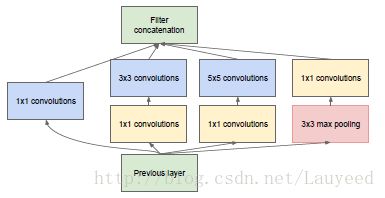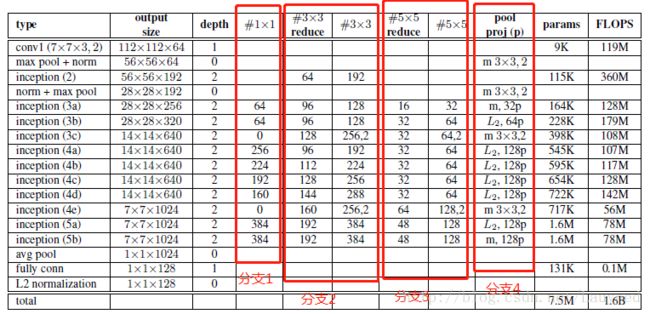【学习日记】人脸识别FaceNet之深度卷积网络NN2解读
这篇日记解读FaceNet的深度卷积网络NN2,并使用Tensorflow实现。
NN2网络的结构如下图所示:
NN2网络几乎和Inception V1一样,所以如果没有Inception V1的基础,依靠上面这张表格使用Tensorflow实现代码还是有点困难的。
这里先介绍inception模块。
inception模块是由谷歌发明的,并在2014年ILSVRC比赛中获得第一名。其主要解决两个问题:
1. 实现不同卷积核的自动选择,也就是说让网络自行决定是使用1*1卷积核,还是3*3,或是5*5,或者是否加池化层
2. 使用了1*1卷积,将时间复杂度,也就是浮点运算数大大降低。
inception模块如下图所示:
总共有4个分支,第一个分支是1*1卷积,第二个分支是实现3*3卷积,第三个分支是实现5*5卷积,第4个分支是实现最大池化。
在每一个分支里,都使用了1*1卷积来减少时间复杂度(运算量)。
4个分支的不同参数在上面的表格分布如下:
分支1中#1*1位0意味着不存在该分支
分支2中的#3*3 reduce就是inception模块中的1*1卷积,数字后面加2的意思是步长为2
分支3中的#5*5 reduce就是inception模块中的1*1卷积
分支4中m表示池化类型为最大池化,L2表示池化类型为L2池化,2表示步长为2, 128P表示通道缩减为128,没有的话表示不减少通道数。
通过以下代码(NN2.py),即可实现上述卷积网络的构建:
import tensorflow as tf
from tensorflow.contrib.layers import conv2d, max_pool2d, avg_pool2d, fully_connected
import time
def NN2(x):
net = conv2d(x, 64, 7, stride=2, scope='conv1')
net = max_pool2d(net, [3, 3], stride=2, padding="SAME",scope='max_pool1')
net = conv2d(net, 64, 1, stride=1, scope='inception2_11')
net = conv2d(net, 192, 3, stride=1, scope='inception2_33')
net = max_pool2d(net, [3, 3], stride=2, padding="SAME",scope='max_pool2')
# inception3a
net = inception(net,1,64,96,128,16,32,32,scope='inception3a')
# inception3b
net = inception(net,1,64,96,128,32,64,64,scope='inception3b')
# inception3c
net = inception(net,2,0,128,256,32,64,0, scope='inception3c')
# inception4a
net = inception(net,1,256,96,192,32,42,128,scope='inception4a')
# inception4b
net = inception(net,1,224,112,224,32,64,128,scope='inception4b')
# inception4c
net = inception(net,1,192,128,256,32,64,128,scope='inception4c')
# inception4d
net = inception(net,1,160,144,288,32,64,128,scope='inception4d')
# inception4e
net = inception(net,2,0,160,256,64,128,0,scope='inception4e')
# inception5a
net = inception(net,1,384,192,384,48,128,128,scope='inception5a')
# inception5b
net = inception(net,1,384,192,384,48,128,128,scope='inception5b')
# avg pool
net = avg_pool2d(net, [7,7], stride=1, scope='avg_pool')
# fc
net = tf.reshape(net, [-1,1024])
net = fully_connected(net, 128, scope='fc')
# L2 norm
net = l2norm(net)
return net
def inception(x, st, b1c, b2c1, b2c2, b3c1, b3c2, b4c, scope):
with tf.name_scope(scope):
if b1c>0:
branch1 = conv2d(x, b1c, [1,1], stride=st)
branch2 = conv2d(x, b2c1, 1, stride=1)
branch2 = conv2d(branch2, b2c2, 3, stride=st)
branch3 = conv2d(x, b3c1, 1, stride=1)
branch3 = conv2d(branch3, b3c2, 5, stride=st)
branch4 = max_pool2d(x, [3, 3], stride=st, padding='SAME')
if b4c>0:
branch4 = conv2d(branch3, b4c, 1, stride=1)
if b1c>0:
net = tf.concat([branch1, branch2, branch3, branch4], 3)
else:
net = tf.concat([branch2, branch3, branch4], 3)
return net
def l2norm(x):
norm2 = tf.norm(x, ord=2, axis=1)
norm2 = tf.reshape(norm2,[-1,1])
l2norm = x/norm2
return l2norm
if __name__=="__main__":
time1 = time.time()
import numpy as np
x = np.float32(np.random.random([10,224,224,3]))
net = NN2(x)
time2 = time.time()
print("Using time: ", time2-time1)


